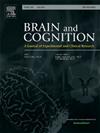短期声音识别的神经生理学相关性:来自脑磁图的见解
IF 1.4
3区 心理学
Q3 NEUROSCIENCES
引用次数: 0
摘要
本研究采用相同与不同的听觉范式来研究预测编码(PC)框架下的短期听觉识别。使用脑磁图(MEG),我们捕捉到与单一声音短期记忆任务相关的神经生理关联。26名健康参与者的任务是识别所呈现的声音与一系列标准声音的相同或不同。一段白噪音将目标与标准分隔开来。脑磁图传感器水平的结果显示,与不同的声音相比,对相同声音的识别引起了两个显著更强的事件相关场的负成分。第一个是N1m,在声音开始后100毫秒达到峰值,而第二个是在300到600毫秒之间出现的较慢的负分量。这种效应在几个重要的MEG传感器簇中观察到,特别是颞和顶叶区域。相反,不同的声音比相同的声音产生了分散的、较小的、更强的活动簇,在声音开始后600毫秒后达到峰值。使用波束形成算法的源重建显示,在两种情况下,听觉皮质、海马和扣带回都受到了影响。总的来说,研究结果与PC原理和先前关于听觉识别的大脑机制的研究结果是一致的,强调了在有意识的短期记忆背景下,早期和后期的消极大脑反应与成功预测先前听过的声音的相关性。本文章由计算机程序翻译,如有差异,请以英文原文为准。
Neurophysiological correlates of short-term recognition of sounds: Insights from magnetoencephalography
This study employed a same versus different auditory paradigm to investigate short-term auditory recognition within a predictive coding (PC) framework. Using magnetoencephalography (MEG), we captured the neurophysiological correlates associated with a single-sound, short-term memory task. Twenty-six healthy participants were tasked with recognizing presented sounds as same or different compared to strings of standards. A white noise interlude separated targets from standards. MEG sensor-level results revealed that recognition of same sounds elicited two significantly stronger negative components of the event-related field compared to different sounds. The first, N1m, peaking 100 ms post-sound onset, while the second corresponded to a slower negative component arising between 300 and 600 ms. This effect was observed in several significant clusters of MEG sensors, especially temporal and parietal regions. Conversely, different sounds produced scattered and smaller clusters of stronger activity than same sounds, peaking later than 600 ms after sound onset. Source reconstruction using beamforming algorithms revealed involvement of auditory cortices, hippocampus, and cingulate gyrus in both conditions. Overall, results are coherent with PC principles and previous results on the brain mechanisms underlying auditory recognition, highlighting the relevance of early and later negative brain responses for successful prediction of previously listened sounds in the context of conscious short-term memory.
求助全文
通过发布文献求助,成功后即可免费获取论文全文。
去求助
来源期刊

Brain and Cognition
医学-神经科学
CiteScore
4.60
自引率
0.00%
发文量
46
审稿时长
6 months
期刊介绍:
Brain and Cognition is a forum for the integration of the neurosciences and cognitive sciences. B&C publishes peer-reviewed research articles, theoretical papers, case histories that address important theoretical issues, and historical articles into the interaction between cognitive function and brain processes. The focus is on rigorous studies of an empirical or theoretical nature and which make an original contribution to our knowledge about the involvement of the nervous system in cognition. Coverage includes, but is not limited to memory, learning, emotion, perception, movement, music or praxis in relationship to brain structure or function. Published articles will typically address issues relating some aspect of cognitive function to its neurological substrates with clear theoretical import, formulating new hypotheses or refuting previously established hypotheses. Clinical papers are welcome if they raise issues of theoretical importance or concern and shed light on the interaction between brain function and cognitive function. We welcome review articles that clearly contribute a new perspective or integration, beyond summarizing the literature in the field; authors of review articles should make explicit where the contribution lies. We also welcome proposals for special issues on aspects of the relation between cognition and the structure and function of the nervous system. Such proposals can be made directly to the Editor-in-Chief from individuals interested in being guest editors for such collections.
 求助内容:
求助内容: 应助结果提醒方式:
应助结果提醒方式:


